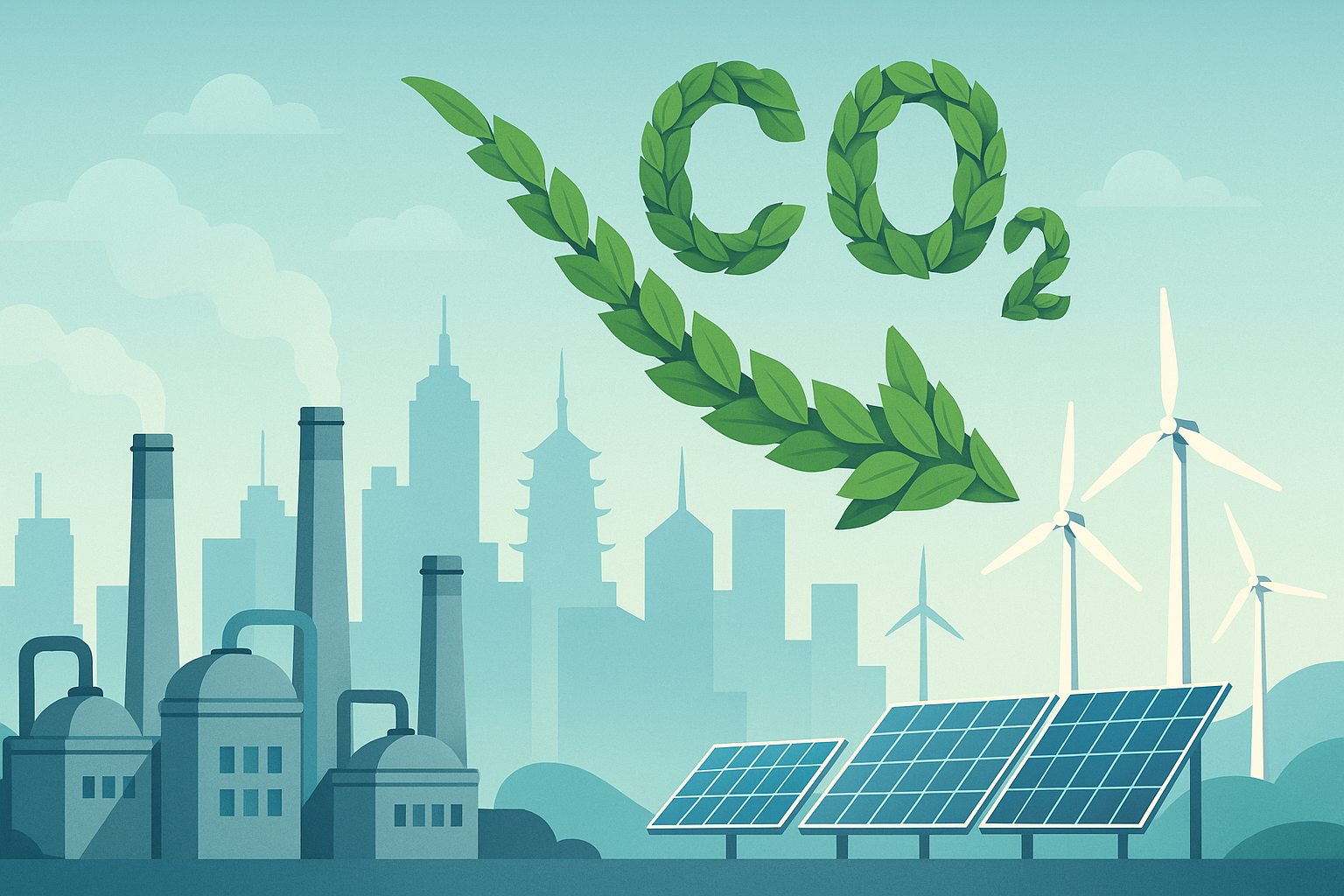China's energy transition: Renewable bring CO2 emissions to sink for the first time
Innovation leap: How China Structurally reduced fossil fuels
China shows a remarkable change: After years of steady climbing of his CO2 emissions, a decline can now be seen that used in earlier than planned. This development is closely linked to the unprecedented expansion of renewable energies, while the global clean energy generation has achieved a historical milestone. For the first time since the 1940s, renewable energies and nuclear power together deliver more than 40% of global electricity generation. Particularly noteworthy: China lists this emission decline despite increasing electricity requirements - a sign that the massive expansion of renewable energies actually begins to structurally reduce dependence on fossil fuels.
Suitable for:
- China, USA, Europe & Co. - The industrialized nations are driving the expansion of renewable energies worldwide in such different ways
The unexpected decline in Chinese emissions
China, the world's largest CO2 emittee, shows a surprising trend: According to current analyzes, the country's CO2 emissions have dropped by around 1% in the past 12 months, with a particularly clear decline of 1.6% in the first quarter of 2025 compared to the previous year. This is a remarkable progress, especially since it is the first time that emissions decrease while energy consumption increases at the same time.
China's CO2 emissions stagnated in the past 2024 quarter compared to the same period. Although CO2 emissions climbed by about 0.8% for the year 2024, they remained below the level of the previous year in the last 10 months of the year. This development indicates a structural change, because the decline is provided about six years earlier than in the original plans of the Chinese government.
There are several reasons for this positive development: In addition to the massive expansion of renewable energies, economic factors also play a role. CO2 emissions in steel and cement production fell by 3% or 11%, which is partly due to problems in the construction and real estate sector. In addition, lower oil consumption, including through the increasing use of electric vehicles, contributes to the decline in emissions.
The influence of climate factors
Despite this positive development, it should be noted that during the heat waves in August and September 2024 the demand for electricity rose due to the increased use of air conditioning systems. This led to an increase in power generation from coal by 2% and from gas by 13%. This seasonal effect underlines the challenges of continuous reduction in emissions under changing climatic conditions.
China's unprecedented expansion of renewable energies
The main driver for the emission decline is China's historical expansion in the field of renewable energies. At the end of 2024, the cumulative installed capacity of renewable energies in China reached the impressive value of 1.889 billion kilowatts, which corresponds to an increase of 25% compared to the previous year. The proportion of renewable energies in the entire installed electricity generation capacity of China thus reached the record 56%.
It is particularly noteworthy that 86% of the electricity capacity in China, which is newly installed in 2024, comes from renewable sources. The newly installed capacity of renewable energies was 373 million kilowatts, which corresponds to an annual increase of 23%. The solar energy dominated with an increase of 278 million kilowatts.
Solar and wind power overtake fossil fuels
A historic milestone was reached at the end of March 2025: China's wind and solar capacity rose to 1,482 gigawatts and thus exceeded the thermal power generation capacity from fossil fuels for the first time. This turning point marks an important step in China's energy transition.
China has reached its goal for 2030 to increase the installed wind and solar capacity to 1,200 gigawatts six years earlier. This enormous expansion is also reflected in the figures for 2024: This year China alone added 277.2 GW to solar capacity, which corresponds to 65% of the total newly installed capacity and represents an increase of 28% compared to the previous year.
It is also impressive that in December 2024 China 68.3 GW brought new solar capacity to the net - more than the entire cumulative solar capacity of Australia, which has been installed in recent decades. The installed wind power capacity in China has been in the change since 2013, while the installed solar capacity has risen by 180 times.
Global boom in renewable energies
China's development is part of a global trend. In 2024, electricity generation from renewable energies and nuclear power reached a historical milestone: it provided 40.9% of global electricity generation - the highest proportion since the 1940s.
The global capacity for renewable energies grew by a record of 585 GW in 2024, which corresponds to 92.5% of the total capacity extension and represents an unprecedented annual growth rate of 15.1%. The solar energy dominated with a contribution of 452 GW, which is more than three quarters of the new capacity.
In 2024, renewable energies delivered a record of 858 TWH additional energy, 49% more than the previous maximum of 2022. The solar energy recorded growth of 29% and was the fastest growing energy source for the 20th time in a row. Solar power generation has doubled in just three years and delivered more than 2,000 TWh of electricity in 2024, which corresponds to a share of 6.9% in global power generation.
Investments and global distribution
Investing into the transition to low-carbon energy has increased by 11% worldwide and achieved a record of $ 2.1 trillion in 2024. Electrified transport, renewable energy and power grids were the largest investment drivers.
However, there are significant geographical differences in the expansion of renewable energies. Most of the growth took place in Asia, with the largest share in China - almost 64% of the globally added capacity. Central America and the Caribbean, on the other hand, contributed only 3.2%. The G7 and G20 countries were responsible for 14.3% or 90.3% of the new capacity in 2024.
Suitable for:
- China's energy transition: away from subsidies and fixed feed -in tariffs to the market -oriented price system
China's renewable energies: progress despite network problems
Despite the impressive progress, important challenges remain. Although the proportion of renewable energies has increased in the electricity generation capacity in China, its share of the actual generation of electricity has not increased accordingly. At the end of the first quarter of 2025, wind and solar together only contributed 22.5% to electricity consumption, although they made up over half of the entire installed capacity. This indicates problems with network access, since network operators continue to prefer electricity from fossil fuels.
Another problem is the lack of network integration: a significant part of the wind and solar energy generated is wasted because the network systems are not yet sufficiently prepared to process them. The decreasing international demand for Chinese wind turbines and solar modules, partly due to increasing protectionist measures, prompted China to “prefer” its domestic capacity for renewable energies.
Why the capacity does not grow fast enough
Despite impressive numbers, progress in renewable energies is not yet sufficient to achieve the goals of the Paris climate agreement. The capacity must grow by 16.6% annually by 2030 in order to achieve the goal of tripling the installed renewable energy capacity. According to current forecasts, the global renewable capacity is expected to grow by 2.7 times by 2030, which is still missing the goal of the tripling.
In addition, emissions from the global electricity sector rose by 1.7% compared to 2023 in 2024. This is, among other things, that despite the leading share of renewable energies on new buildings, the global energy landscape is still heavily dependent on fossil power plants, which continue to consume large amounts of coal, gas and oil.
China's CO2 turn: Hope for the global climate future
The unexpected decline in China's CO2 emissions marks an important turning point in the global struggle against climate change. It shows that even in a country with enormous energy and strong economic development, it is possible to switch to renewable energies and can actually lead to a reduction in emissions.
The massive expansion of renewable energies in China and worldwide gives rise to careful optimism. The record expansion of solar and wind energy as well as the increasing investments in green technologies indicate an accelerated energy transition. If this trend continues and the remaining challenges in network integration and the breakdown of fossil capacities are managed, this could make a decisive contribution to limiting the global increase in temperature.
China's experiences could serve as a model for other countries and show that faster decarbonization is possible than previously assumed. The unexpected decline in emissions in China is a positive signal that gives hope that the global climate goals could still be available.
Suitable for:
Innovative photovoltaic solution to reduce costs (up to 30%) and save time (up to 40%)
More about it here:
Your partner for business development in the field of photovoltaics and construction
From industrial roof PV to solar parks to larger solar parking spaces
☑️ Our business language is English or German
☑️ NEW: Correspondence in your national language!
I would be happy to serve you and my team as a personal advisor.
You can contact me by filling out the contact form or simply call me on +49 89 89 674 804 (Munich) . My email address is: wolfenstein ∂ xpert.digital
I'm looking forward to our joint project.


